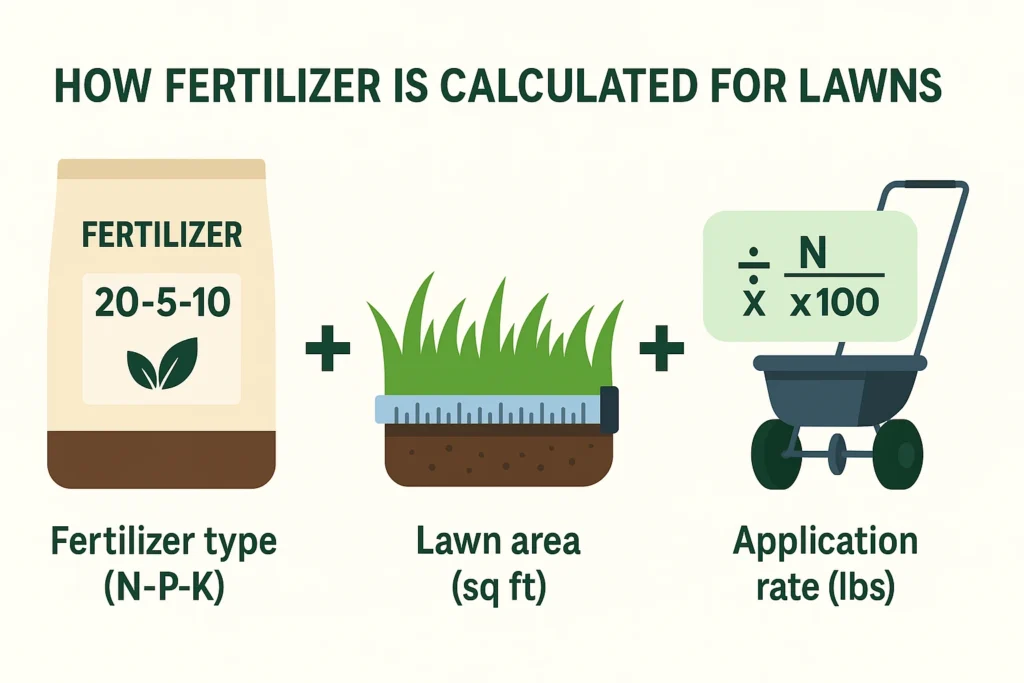Lawn Fertilizer Calculator
Lawn Fertilizer Calculator – Find the Right Fertilizer for a Healthy Lawn

Created by James S. Lockwood
With a background in botany and ecological sciences, James specializes in creating practical tools and resources to help gardeners, farmers, and plant enthusiasts optimize their green spaces.
Our Lawn Fertilizer Calculator helps you apply the right amount of nutrients to your lawn—no more guesswork, overfeeding, or wasted product. Whether you’re using granular or liquid fertilizer, this tool calculates exactly how much you need based on your lawn size and the NPK ratio of your product. Just enter a few details, and get a customized application rate to keep your grass green, healthy, and thriving.
Table of Contents

How Much Fertilizer Does My Lawn Need?
The exact amount of fertilizer your lawn needs depends on three things: your lawn’s size, the nutrient content of your fertilizer, and how much nitrogen you want to apply per 1,000 square feet. A general rule of thumb is to apply 1 pound of nitrogen per 1,000 sq ft of grass. This amount promotes steady growth without overfeeding or burning your turf.
To figure out how much product to use, you need to know the nitrogen percentage in your fertilizer. For example, a fertilizer labeled 30-0-10 contains 30% nitrogen. Using our lawn fertilizer calculator, you can plug in your lawn size and fertilizer type to get a precise result in pounds — no guessing required.
Over-fertilizing can damage your lawn and waste money. Under-fertilizing leaves your grass thin and pale. That’s why using a lawn fertilizer calculator is the easiest way to apply the right amount, every time.
How the Lawn Fertilizer Calculator Works?
The lawn fertilizer calculator uses a simple formula to determine how much fertilizer your lawn needs based on its size and the nitrogen percentage in your fertilizer. Most lawns require 1 pound of nitrogen per 1,000 square feet for each feeding. To find out how much product to apply, the calculator uses this formula:
Fertilizer Needed (lbs) = (Lawn Area in sq ft ÷ 1,000) × (1 ÷ (% Nitrogen ÷ 100))
For example, if you have a 5,000 sq ft lawn and you’re using a fertilizer with 30% nitrogen, the calculator will show you need about 16.7 lbs of product to deliver the ideal amount of nitrogen. This method ensures precise application and avoids overfeeding, which can damage your lawn or the environment.
What Are NPK Ratios for Lawns?
NPK stands for nitrogen (N), phosphorus (P), and potassium (K) — the three primary nutrients in lawn fertilizer. The numbers on a bag, like 30-0-10, represent the percentage of each nutrient by weight. For example, 30-0-10 contains 30% nitrogen, 0% phosphorus, and 10% potassium.
For most lawns, nitrogen is the most important nutrient. It drives leaf and blade growth, giving grass its lush, green color. Phosphorus supports root development but is often limited due to environmental regulations. Potassium helps with stress tolerance and overall health, especially in drought or cold conditions.
The ideal NPK ratio depends on your grass type and soil condition, but common lawn fertilizers include 30-0-10, 21-0-0, or 10-10-10 for general feeding. The lawn fertilizer calculator uses your chosen ratio to calculate the correct application rate, ensuring your lawn gets the nutrients it needs—nothing more, nothing less.
How the Lawn Fertilizer Calculator Uses N-P-K Ratios?
The lawn fertilizer calculator is based on the N-P-K ratio of your chosen product, especially the nitrogen value. Nitrogen is the most important nutrient for lawns, promoting growth and rich green color. For example, Urea (46-0-0) contains 46% nitrogen. The lawn fertilizer calculator adjusts your application rate based on this key number.
Choose the Right Fertilizer Type
To get an accurate result from the lawn fertilizer calculator, start by selecting the type of fertilizer you’re using. Each option has a different nitrogen (N) content, which determines how much product your lawn needs.
Urea (46-0-0): This is a high-nitrogen synthetic fertilizer, with 46% nitrogen content. It’s highly concentrated and effective for lawns that need a strong nitrogen boost.
10-10-10: A balanced, all-purpose fertilizer with 10% nitrogen. Suitable for general lawn and garden use, especially in new or nutrient-deficient soils.
Compost (1-1-1): An organic option with low nitrogen content. Great for improving soil health over time, but may not deliver quick results for lawn greening.
Always match your fertilizer type to your lawn’s needs and your personal preference for organic vs. synthetic inputs. The calculator adjusts automatically based on your selection.
Nitrogen Requirements for Different Grass Types
Different grass types require different amounts of nitrogen per year. Below is a quick guide:
Kentucky Bluegrass
🌿 3 - 5 lbs of Nitrogen
Bermuda Grass
🌿 4 - 6 lbs of Nitrogen
Tall Fescue
🌿 2 - 4 lbs of Nitrogen
St. Augustine
🌿 3 - 4 lbs of Nitrogen
Zoysia
🌿 2 - 3 lbs of Nitrogen
Centipede Grass
🌿 1 - 2 lbs of Nitrogen
The calculator adjusts fertilizer recommendations based on the selected grass type and fertilization schedule (spring, summer, fall, or winter).
When to Use the Lawn Fertilizer Calculator?
Timing matters. Fertilizer is most effective when applied during your lawn’s active growing season. Cool-season grasses like fescue and rye benefit from fertilization in early spring and fall, while warm-season grasses like Bermuda and zoysia respond best to feeding in late spring and summer. To dive deeper into the best times to fertilize and seed, visit our full guide:
👉 Best Time to Plant Grass Seed
Best Grass for Your Soil Type
Not all grasses grow well in every soil. If you’re working with sandy soil, nutrients drain quickly, and you’ll need grass varieties that can handle dry, fast-draining conditions. Our guide to the best options covers everything from drought-tolerant species to fertilizer tips for sandy lawns.
👉 Best Grass for Sandy Soil
Fertilizing Tips by Grass Type
Different grass types have different fertilizer needs. The lawn fertilizer calculator helps adjust your feeding rate, but understanding your grass is just as important:
Bermuda: Grows fast and thrives with light, frequent feeding during warm months. Use high-nitrogen fertilizers.
Fescue: Performs best with heavier feeding in fall. Avoid over-fertilizing in summer.
Zoysia: Grows slowly, prefers a moderate NPK ratio, and benefits from fewer but balanced applications.
St. Augustine: Sensitive to high nitrogen. Apply with care unless you want faster growth and more mowing.
Use the lawn fertilizer calculator to fine-tune your plan based on grass type, and combine it with proper timing and product choice for best results.
How Much Fertilizer Per 1,000 Square Feet?
The ideal amount depends on your grass type and fertilizer choice. Below are some common recommendations:
Urea
🧪 N-P-K: 46-0-0
📏 Application Rate: 1 lb of nitrogen = 2.2 lbs of fertilizer
10-10-10
🧪 N-P-K: 10-10-10
📏 Application Rate: 10 lbs of fertilizer per 1,000 sq ft
Compost
🧪 N-P-K: 1-1-1
📏 Application Rate: 100 lbs of fertilizer per 1,000 sq ft
Use our Lawn Fertilizer Calculator to get instant and accurate results for your lawn!
How to Mix DEF for Lawn Fertilizer Calculator?
For liquid fertilizer application, you need to mix water and fertilizer correctly to prevent over-fertilization.
- For granular fertilizer: Use 1 lb per 1,000 sq ft, spread evenly, and water after application.
- For liquid fertilizer: Use 1 gallon per 1,000 sq ft, ensuring uniform coverage.
- For slow-release fertilizers: Apply in spring and fall for sustained nutrition.
Frequently Asked Questions (FAQs)
1. How do I know how much fertilizer to apply?
Use our Lawn Fertilizer Calculator! Enter your lawn size, select your grass type, and choose the fertilizer type to get instant recommendations.
2. What is the best fertilizer ratio for lawns?
A balanced N-P-K ratio of 3-1-2 or 4-1-2 works best for most lawns, but it depends on the grass type and soil test results.
3. When should I fertilize my lawn?
✔ Spring – High nitrogen for growth
✔ Summer – Light feeding to avoid burning
✔ Fall – Balanced nutrients for root strength
✔ Winter – Slow-release fertilizer for dormant feeding
4. Can I use organic fertilizer instead of synthetic?
Yes! Organic options like compost, manure, and bone meal provide nutrients over time and improve soil health.
5. How do I avoid over-fertilizing my lawn?
Over-fertilization can burn grass and cause runoff pollution. Stick to recommended nitrogen rates based on grass type and avoid applying too frequently.
6. How do I calculate fertilizer per 1,000 square feet?
Use this simple formula:
Fertilizer Needed (lbs) = (Lawn Area × Recommended N Rate) ÷ Fertilizer N Content
7. Can I use liquid fertilizer instead of granular?
Yes! Convert granular to liquid using 1 gallon per 1,000 sq ft as a general guide.
8. Does fertilizer expire?
Granular fertilizers last years if stored dry, while liquid fertilizers may degrade over time.
Disclaimer for Lawn Fertilizer Calculator
This Lawn Fertilizer Calculator provides estimates based on standard recommendations. Actual fertilizer needs may vary due to soil conditions, climate, and specific grass variety. Always follow local guidelines and consult a lawn care professional before applying fertilizer. Use at your own discretion.
Discover Crop & Farming Calculators
